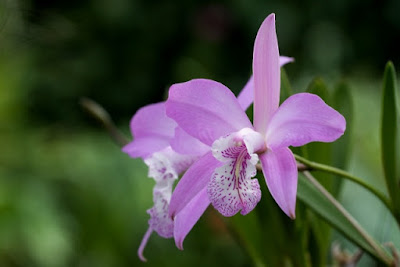Laelia speciosa is native to Mexico. These plants meet on a large area of the central plateau and surrounding uplands in the states of Durango, Zacatecas, Aguascalientes, Jalisco, Guanajuato, Michoacan, Queretaro, Hidalgo, San Luis Potosí and Tamaulipas...
Laelia speciosa also called as May-flowered, Showy Laelia, Amalia grandiflora, Amalia majalis, Bletia grandiflora, Bletia speciosa, Cattleya grahami, Cattleya majalis, Laelia grandiflora, Laelia grandiflora var. alba, Laelia majalis, is a species of the genus Laelia. This species was described by Rudolf Schlechter in 1914.
IDENTIFY LAELIA SPECIOSA
Laelia speciosa is native to Mexico. These plants meet on a large area of the central plateau and surrounding uplands in the states of Durango, Zacatecas, Aguascalientes, Jalisco, Guanajuato, Michoacan, Queretaro, Hidalgo, San Luis Potosí and Tamaulipas. They grow on oaks in rare, dry, deciduous, dwarfish forests, at an altitude of 1900-2500 m above sea level.
May-flowered is a cool to cold growing, small sized epiphyte, which reaching a height of 18-20 cm, with subglobose to ovoid, rugose, 5 cm long pseudobulbs carrying 1 to 2 lanceolate-elliptic, acute, coriaceous-fleshy, green suffused with purple, basally clasping, 13-15 cm long leaves.
Showy Laelia blooms in the spring and summer with an apical, 12 to 15 cm long inflorescence which arises from a newly developing pseudobulb and carries 1 to occasionally 4, fragrant flowers. The flowers are 10-15 cm in diameter with considerable texture. They are persistent, with a slight scent like violets. The pointed petals of the outer and inner whorls are almost the same length, but the petals of the inner whorl are twice as wide. The petals are usually pale-pink-lilac, but the flowers can also be very dark or very pale. The three-lobed lip with pinkish-green edges is white in the middle, with short, lavender-red lines randomly distributed in the throat and the middle part. The red lines on the lip create a unique pattern that is said to be as flippant as fingerprints. Mud flaps are straight on each side of the spine. The almost round, expanding middle part has undulating edges, with a yellow line going from the inside, the widest at the base. Plants with completely white flowers are found, but they are rare.
LAELIA SPECIOSA CARE AND CULTURE
Cultural information should only be used as a guide, and should be to be adapted to suit you. Your physical location; where you grow your plants, how much time you have to devote to their care, and many other factors, will need to be taken into account. Only then can you decide on the cultural methods that best suit you and your plants.
Light:
Laelia speciosa needs a light level of 30000-40000 lux. A clear position is required. At noon, the light should be filtered or dispersed to avoid burns. Strong air movement should be ensured all the time.
Temperature:
It is a thermophilic plant. In summer, when the average temperature is 24-27 ° C at night 12-13 ° C , with an amplitude of daily 12-14 ° C . The average temperature is in the winter day 19-21 ° C at night, 3-5 ° C , the difference in dose of 15-17 ° C .
Humidity:
May-flowered needs the average humidity of 65% for most of the year, falling to around 55% at the end of the dry season, which falls in late winter and early spring.
Substrate, growing media and repotting:
It is recommend mounting Laelia speciosa on cork or tree ferns. Fixed plants, however, require high humidity, and at least daily watering in the summer, and it may even be necessary to water several times a day if the weather is dry and very hot.
These plants can also grow in pots filled with a loose, well-permeable substrate, allowing the roots to quickly dry after watering. Fir bark or medium granule cork pieces are also suitable substrates.
The plants should be repotted before the substrate is used up, or when the plant grows from its pot. If they are repotted immediately after starting new root growth, they will reach their normal state faster; be careful with new roots because they are very fragile.
Watering:
From late spring to early autumn, for 4-5 months, rainfall is low to moderate. Their number decreases rapidly in the autumn and remains low for 7-8 months of drought lasting until late spring. The cultivated plants should be frequently watered during a period of strong growth, but they must dry fast after watering. The amount of water should be significantly reduced when new growths reach maturity in the autumn.
Fertilizer:
During the active growth, the plants should be fertilized every week 1/4-1/2 of the recommended dose of fertilizer for orchids. You can use nitrogen-poor fertilizers and rich in phosphorus during late summer and autumn.
Rest period:
In autumn, the amount of water for Laelia speciosa should be reduced. And indeed, they requires drying in autumn and staying in this state for quite long periods between watering. Morning misting provides from time to time adequate humidity for most areas. In winter and early spring, even fogging should be reduced, because the plants must stay dry for several weeks. A rest period in drought and cold is absolutely necessary. Fertilization should be limited or should be completely abandoned until spring, when stronger watering resumes. In the natural habitat, the light is strongest in the dry winter period, so the plants grown need as much winter light as possible.















COMMENTS